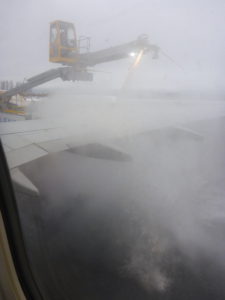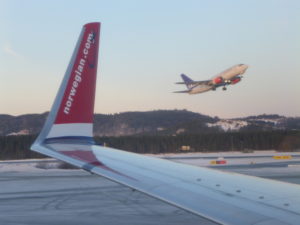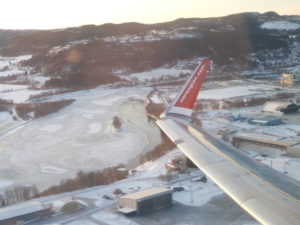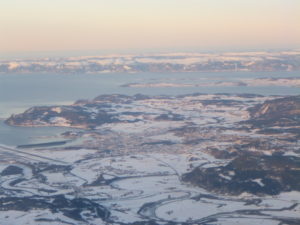A Greater Contrast?
Yesterday on January 24th we took Zoonie downriver for her first excursion since November 2016 when we arrived on these shores. With us were Ben, Marine Manager of McKay Electronics, who has supported us all through Zoonie’s re-fit, and young Mark who straightaway put his electrician’s skills into practice to fix the navigation lights up forward.
There is a nice little basin of deep water just beyond Port Whangarei Marine Centre and Ben asked Rob to put Zoonie into a slow circular turn there so he could calibrate the Auto Pilot compass using the guidelines in the manual on his mobile phone to help. Our device had to take its time using our GPS to install the essential information, as it progressed a red line across the bottom of the small display screen would slowly turn blue. The reason it didn’t to begin with was because Zoonie was turning too slowly, so we upped her speed to four knots. Between 3 and 15 knots was recommended, but we laughed at the higher speed, unobtainable by us but a bit reckless it sounded for any vessel. Still it was all giving Rupert, Zoonie’s engine, a good run.
The little blue line was nearly complete and then a new set of instructions appeared to check for deviation, caused by the position of the compass in relation to metallic objects on board that could distort its magnetism. Up to 15 degrees was acceptable but ours lit up as 211 degrees. The boys went below to play games moving the compass around until the deviation was down to an acceptable 11 degrees. Zoonie’s flags now sit either side of it in the cupboard under the chart table.
One look at the green colour of the water after all the recent rain told us here was not the place to check the watermaker, so that is a job Rob and I will do soon when we take Zoonie out to sea for a brief spell, maybe this weekend.
Our new autopilot then brought us all the way back to the lifting bridge and then beyond with Rob just tweaking our course by increasing or decreasing its heading by increments of 1 or 10 degrees.
It was a beautiful day from start to finish, in fact over the radio, as the day progressed, records started in 1905 were being broken for the day time temperature on the 24th January. The sun rose high over our heads and beat down hard from Northland, where we are, to Invercargill on the southern tip of the south island, both locations reaching 32 degrees in the afternoon. In Zoonie’s saloon it was 36 degrees, reminiscent of Bahia in Ecuador. This heat wave is set to continue for a week, causing our fridge to be on constantly in the day, a bit of a worry because of the electricity it will consume when we are not connected to the mains and relying on solar and wind power, and Rupert as a last resort. (At the moment of writing it is 5.35am and a blissfully comfortable 20’ in the saloon, light is just creeping into the eastern sky and my Tui is keeping me company)
In our experience it would be hard to think of a greater temperature contrast to the equally beautiful weather we experienced within the last three weeks in Norway, where the sun just manages to peep above the hills to the south of Stjordal at the far end of the Trondheim Fjord for a very few hours of winter daylight and the temperature ranged from minus 8 degrees there at sea-level to minus 28 at Roros just over 2000 feet up and inland towards Sweden.
Our hosts were Inyeborg and Geir who are parents of Hanne who is married to Havard and now have two lovely little boys, Edvin and Alexander and Helene who is a physiotherapist and lives with her boyfriend, Carl Eric in Trondheim.
Hanne and her friend, Tina came to stay with Emily and me as foreign language students many years ago when I wanted Emily to have experiences with people from other countries and cultures as she grew up. I have stayed friends with both families ever since, it just happened that way.
Inyeborg works for the Inland Revenue and Geir is a retired policeman. When I first knew them they lived in a comfy wooden family home with a cellar but with the girls leaving home they have moved into a compact two bedroom flat nearer the centre of town, which is where we stayed.
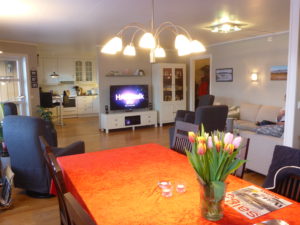

On our first day Geir joined us for a day trip to Trondheim, 40 minutes away by train. We crunched along on gritted compacted ice on the roads and pavements the 10 minute walk to the train station. Where the sun was just making its brief daily appearance.
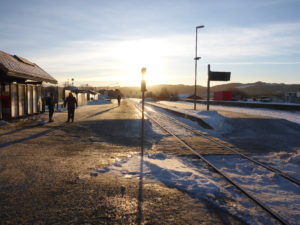
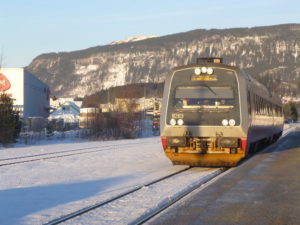
The station area is very open and tidy and the waiting room was warm and bright. Norwegians are so well accustomed to the weather they keep their buildings at around 23 degrees inside, clad their cars with winter tyres, wear quality warm clothes and get on with life as usual. The winter weather is no problem to them because it is regular and not as changeable as ours in the UK.
A simple misunderstanding on English terms kept our ‘look around’ the wooden royal palace in Trondheim to a brief skirt around the outside, when I had thought our ‘look around’ would be the interior for the first time! Apparently it is only open to the public in the summer.
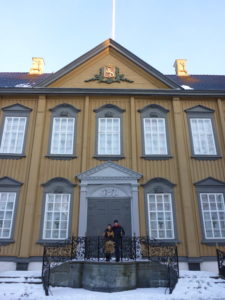
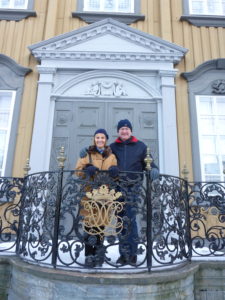
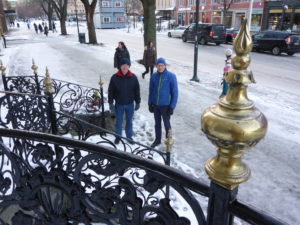
Not a drinker himself I thought it kind of Geir to take us to the Lille London pub where he supped coffee while Rob and I indulged in some American Beer. Onwards and at speed through the increasing cold we planned to meet Ingeborg at the Egon Restaurant in the old docklands, now a fashionable area to spend social time. We always go there on our visits; the sheltered waterways and maritime history of the past, moored boats with some liveaboards (brhhh) and inclusion of the area in the modern Trondheim with walkways everywhere make this area uniquely attractive and very Norwegian.
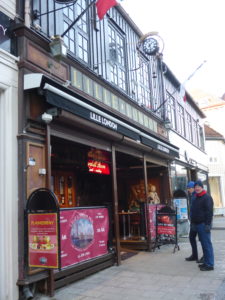

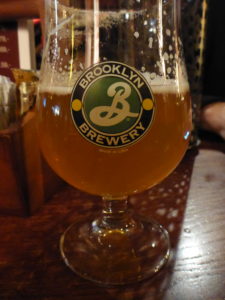
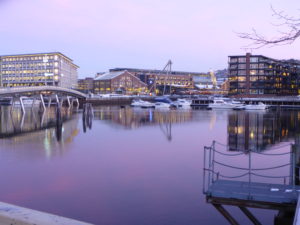
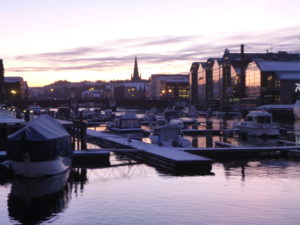
Helene’s apartment has a rounded glazed wall in the living room so that a 180’ view over these waterways can be enjoyed and when we arrived the lights outside complemented the lights on her Christmas tree beautifully. Golden baubles nestled amongst home tied bows of red ribbon on this single splash of bright colour in an otherwise ultra-modern monochrome colour scheme. We were only in Norway for a few brief days but the brevity of our trip was in inverse proportion to the sheer pleasure of seeing our friends once more.
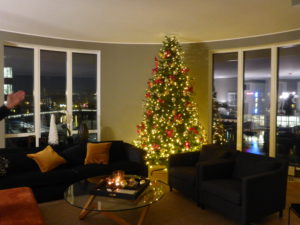
The Roros Express
Geir’s sister Heidi called by first thing the next day to meet Rob and have a brief chat before attending a conference. Inyeborg had taken the day off to accompany the three of us to Roros, always a nice cultural outing for Norwegians and visitors alike.
We crunched over the gritted ice to the station once more to catch the train to Trondheim and change for the train to Roros. Our train was late and that reduced our changeover time from 12 minutes to 3. Mindful of the old crocks with him, Geir with his normal considerate and precise attention to detail spoke with the train crew and told us to stay on our train to a stop further than the one we needed as the Roros train also arrived there but our train had priority over it. Perfect.

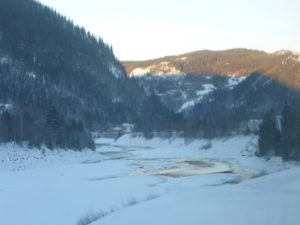
Norway uses a lot of electricity especially in lighting, heating and transport, cars and trains. They are rich in oil at the moment and the glaring impression I could not fail to notice was how well and generously the government spreads its wealth. The areas we saw included a city, a large and typical town, small villages and rural homes and the standard of living is overall comfortable if not very comfortable.
Bundles of children tobogganed down gentle slopes of white and the tracks of mystery animals wandered across virgin snow. The Great Glama River to our right was buried under a layer of snow covered ice. Only little windows in the ice revealed the river flowing unabated beneath. A mist moved gently from the shores into the sugared coniferous woodland.
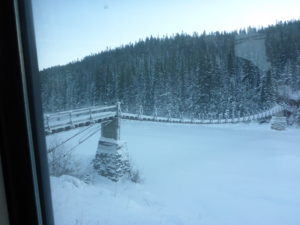
Smoke rose vertically from farmsteads in the intense still of this freezing and slow moving arctic high pressure system that engulfed the country just as a similar slow moving system sits over us now, only this one is from the tropics.
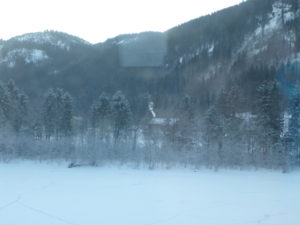
Ochre and ox blood painted wooden buildings contrasted cleanly with the perfect brilliance of the pure driven snow. Such extreme natural beauty must surely affect the minds of the people living there.
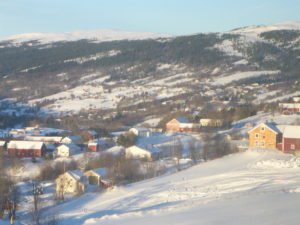
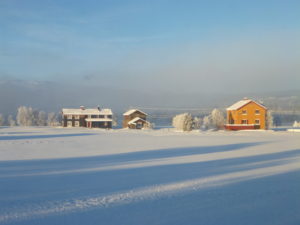
Every time the train approached habitation it sounded its horn and we craned our heads for a better view out of the window. There really wasn’t a moment to lose to visually explore the amazing scene before us from our lovely warm carriage. Our return journey, mid-afternoon, would be mostly in the darkness of another long Norwegian night.
Roros
The first ‘o’ of the town name should have a forward slash through it as it changes the pronunciation but I don’t appear to have that symbol on my keyboard, if I hold down on the ‘o’ I just get oooooooooo!
As our express train came to the end of its ascent from the coast and moved onto the 2000 foot high plateau the sun shone over the snowy countryside and the conifers were left behind in the shade, replaced by softer birch woodland, the naked branches clothed in a silvery silk chemise of powdered snow.
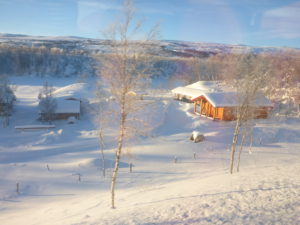
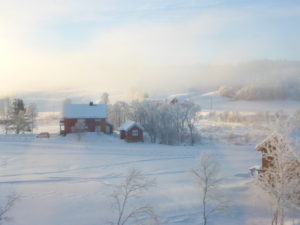
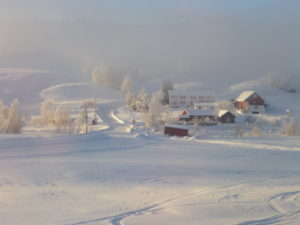
Family friend Elin was there to meet us with her spark, a sit on sled where two can take it in turns to relax or scoot from behind with one foot safely on a runner to prevent a fall. Lots of locals use them in the winter as they are safer than a car and like a zimmer, they give some support to the pusher.
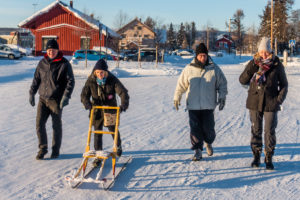
I straightaway noticed there was no grit on the hard packed snow and ice and after a few steps realised that at minus 22 degrees the frozen surface becomes grippy and we managed the fairly steep walk up the road to the church without a slip.
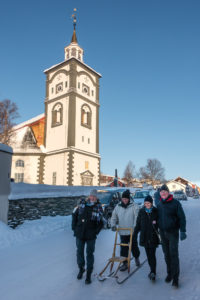
Roros was once a farm, but then copper was discovered on it and provided jobs and fortunes until the enterprise morphed into a museum and the inhabitants of the growing town turned to arts, crafts and musical theatre. In 1980 the town was declared a World Heritage Site which has put it on the global map of places to go and in the summer the crafts markets, music festivals and cultural shows swell the normal population of 3,500 by twenty times.
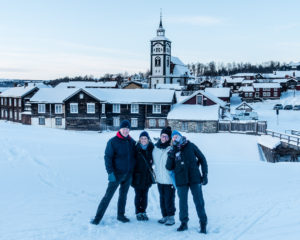
We swelled the population by just four as we admired the 17th and 18th century wooden houses with their dark pitch log walls, snow piled high against them to clear the paths and add insulation to the homes. Most are still lived in and the poorest mining families occupied tiny wooden homes nestled just beneath the slag heaps of mine detritus. Remember the Aberfan disaster in Wales, where a school was engulfed by the slag heap sliding down hill after heavy rain? Just the same these heaps loom over the town and we walked upwards between them for a fine view. Now, covered in purifying white snow they enhance the area but in summer they wouldn’t look so beautiful.
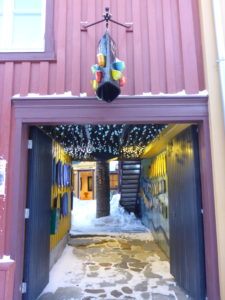
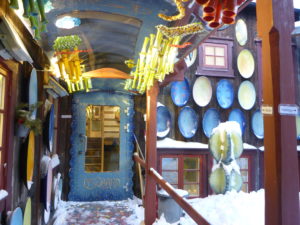

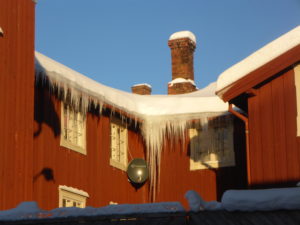
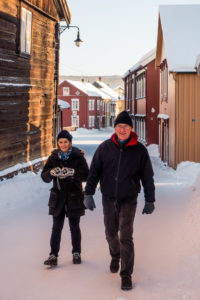

One street has been so designed that it tapers inwards as it ascends uphill. The perspective of the Mayor’s house at the bottom is that from the top it looks bigger than it really is and from the Mayor’s house looking up the street the narrowing towards the top makes the street look longer and grander. Such architectural vanity!
The busy main street shops are full with Nordic items, reindeer hides, woollen clothing, modern extreme weather clothes, pottery items, the list goes on. Many of the homes are built around tiny courtyards, some containing stables, where there would be protection from bitter winds, but not the snow as you can see. Where once sleighs and carriages would have been housed cars now wait.
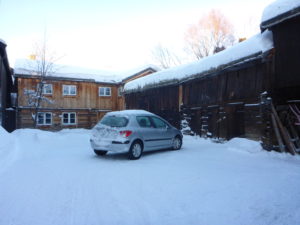
Elin had arranged a dinner for the five of us in a warm little dining room decorated with a Wedgewood style attractive frieze and brass lamps. A simple plate of locally caught fish, boiled small potatoes in their skins and lightly cooked cabbage coleslaw gave us a brief break from our thigh numbing wanderings around this uniquely attractive place.
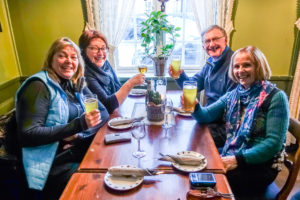
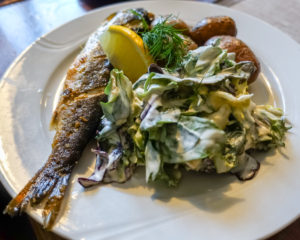
The name comes from ROA meaning a small river, the one you see in the feature photo which enters the Great Glama River at the OS, meaning river mouth.
So soon, mid-afternoon, as the winter light faded into what is eloquently referred to as ‘The Blue Hour’ when everything takes on the hue of shallowing water, we prepared to board our express in the now balmy minus 16 degrees.
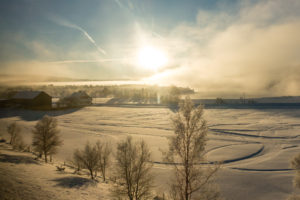
This was my third visit and Rob’s first and it’s the sort of place where for some visceral reason we know we will be back, the journey alone is unmissable on a visit to this part of Norway, in Trondelag County in the Gauldalen Region.
When Hell Freezes Over and a Scrumping Moose
There is a quirky little place just outside Stjordal called Hell which has its very own station and the clever Norwegians have capitalised on the name and the opposite concept of Hell being a hot place. Every year coachloads of Nikon and Canon toting visitors come to visit Hell not only for the essential photo under the name but also because there is a conference centre there for business folk, a big hotel and music concerts, including a famous Blues concert held there annually.
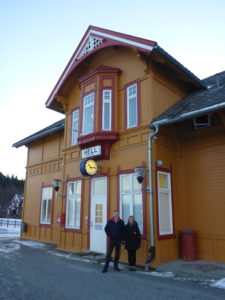
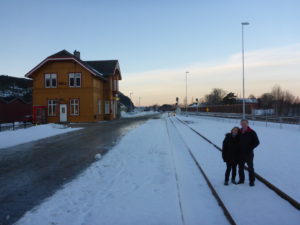
To be fair the summer visitors will miss the opposite temperature significance as it will be pleasantly warm then with not a flake of snow in sight, but it’s still a bit of fun. There is now a new station building but the traditional one is maintained for the sake of tourist photos.
When we went with Geir and Inyeborg to dinner with Hanne, their eldest daughter and her husband Havard just outside Stjordal in a little country town called Skatval we looked through Hanne’s album of her stay with Emily and me from years ago. So much has happened since of course. Hanne married Havard in Rome and now they have two fine little boys, Edvin and baby Alexander.
Ingeborg and I played ball with Edvin in the big L shaped lounge of their lovely family home while a Mexican supper was being prepared. The house is the highest up the hill road out of the town towards the forest and the road ends just at their frontage. There are walks straight into the forest from their front door which are not only used by humans. Last summer Hanne was about to take the children on a trip in the car when she had to wait until a mother moose with her twins had moved on from their driveway. The moose likes to scrump the apples from the trees in their garden so is likely to be a regular visitor.
Just before we sat down to eat Tina and her fiancée Hemming arrived and it was so good to see them again. Tina came with Hanne to stay with us all those years ago and the last time we met was over a weekend in Edinburgh just before we set sail in 2015.

Next Saturday, February 3rd while we are at a music and dance evening in Whangarei where Naylene from the marina office will entertain us on her keyboard, Tina, wearing her grandmother’s re-styled wedding dress and Hemming will be tying the knot in a little church in Trondheim and our thoughts will be with them.
Tina’s parents are no longer together so we had the pleasure of not one but two visits to catch up with them. Jill has her younger daughter Julie and granddaughter Natalie living with her and is regularly visited by Bjord and his delightful Wheaten Terrier, Eba. We had a leisurely supper chatting for some time about New Zealand as Bjord has recently visited with a friend to spot and photograph birds.
Bjord, “So whereabouts are you from in England?”
Rob, “A little place called Oakham near Peterborough,”
Bjord, “Ah Oakham, we had a stand there for three years at the Bird Show,” they went on to discuss local places of shared interest.
Jill has a Nissan Leaf electric car with a range limit depending on the health of the batteries. When Bjord gets the call from the bush telegraph that a rare bird has been spotted at some distant location he doesn’t use Jill’s car as speed is of the essence and he would miss the sighting if he had to stop to re-charge the batteries! I love the diverse human activities we come across in our travels.
Jill and Stein also have a son, Anders who has grown from a computer screen lad into a fine young man. He is now father of five month old Leon and has nearly finished his apprenticeship learning to operate the second tallest tower crane in the world, making the legs for North Sea oil rigs. He spent six months with his partner Astrid in Australia and when he got home had to choose a career path, amazing. When telling this story to friends Rob and I would say “he has a micro-wave, bed, computers….in his cab” and with a slightly concerned tone our friends would enquire, “and a toilet?” Oh yes and a toilet. Should the lift break down it would take Anders, who is young and fit, 20 minutes to climb to his cab.
Stein recently sold his concert sound and lighting company and now works part-time doing the same kind of work, in the newly built cultural centre in Stjordal while waiting for the summer when he will get out on the fjord once more in one of his kayaks.
It was an enriching time visiting them all and I didn’t really start looking ahead again until we were sitting at the end of the runway at Trondheim Airport, which is actually at Stjordal and just five minutes from Geir’s home, watching a guy in his cab spraying our wings to clear them of ice ready for take-off. In one of the photos you can just see Stjordal nestling on the shore of Trondheim Fjord. We will return.
